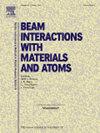预损伤KTaO3中电离驱动的竞争性(恢复)过程:简要综述
IF 1.4
3区 物理与天体物理
Q3 INSTRUMENTS & INSTRUMENTATION
Nuclear Instruments & Methods in Physics Research Section B-beam Interactions With Materials and Atoms
Pub Date : 2025-04-05
DOI:10.1016/j.nimb.2025.165704
引用次数: 0
摘要
核(Sn)和电子(Se)的能量耗散过程被认为是独立的,在很大程度上是不相关的,在过去的几十年里影响了我们对离子-固体相互作用和损伤过程的理解。然而,最近,人们越来越普遍地接受Sn和Se在时间和空间上相互作用时是耦合的。为了解耦这些过程,在实验中使用顺序双光束照射分离这些影响已被接受为促进对硒和可能由位移事件产生的预先存在缺陷之间复杂相互作用的理解的逻辑途径。这种实验方法最近被应用于KTaO3的研究,揭示了对这一关键研究课题的新见解。在这里,我们提供了一个前瞻性的和全面的观点,硒和KTaO3中预先存在的缺陷之间的基本耦合。揭示和讨论了导致损伤愈合的竞争性两阶段相变过程背后的起源。此外,还包括协同效应产生的证据,以供比较。此外,我们的发现是合理的使用硒和离子速度作为关键参数。我们强调了非弹性热峰值(i-TS)计算如何提供对这种耦合过程性质的见解,并进一步证实了离子速度效应控制退火动力学。这项工作强调,通过在材料中引入少量的局部无序,MeV离子辐照(即不是极端Se)也可能是随后材料改性和功能化的另一种选择。本文章由计算机程序翻译,如有差异,请以英文原文为准。
Ionization-driven competitive (recovery) process in pre-damaged KTaO3: A brief review
The nuclear (Sn) and electronic (Se) energy dissipation processes have been considered to be independent and largely uncorrelated, influencing our understanding of ion–solid interaction and damage processes in the last decades. Recently, however, it has become more generally accepted that Sn and Se are coupled as they interact both in time and space. To decouple these processes, separating these effects in experiments using sequential dual-beam irradiations have become accepted as the logical path to advance the understanding of complex interactions between Se and pre-existing defects that may be created from displacement events. This experimental approach has been recently applied to studies of KTaO3 to reveal new insights into this critical research topic. Here, we offer a forward-looking and comprehensive perspective on the fundamental coupling between Se and pre-existing defects in KTaO3. The origins behind the competitive two-stage phase transition process leading to damage healing are revealed and discussed. Furthermore, the evidence resulting from synergistic effects is also included for comparison. Additionally, our findings are rationalized using both Se and the ion velocity as key parameters. We highlight how the inelastic thermal spike (i-TS) calculations provide insights into the nature of this coupled process and further confirm that the ion velocity effect governs annealing kinetics. This work emphasizes that through the introduction of a small amount of local disorder in materials, MeV ion irradiation (i.e., not extreme Se) may also be one additional option in subsequent material modification and functionalization.
求助全文
通过发布文献求助,成功后即可免费获取论文全文。
去求助
来源期刊
CiteScore
2.80
自引率
7.70%
发文量
231
审稿时长
1.9 months
期刊介绍:
Section B of Nuclear Instruments and Methods in Physics Research covers all aspects of the interaction of energetic beams with atoms, molecules and aggregate forms of matter. This includes ion beam analysis and ion beam modification of materials as well as basic data of importance for these studies. Topics of general interest include: atomic collisions in solids, particle channelling, all aspects of collision cascades, the modification of materials by energetic beams, ion implantation, irradiation - induced changes in materials, the physics and chemistry of beam interactions and the analysis of materials by all forms of energetic radiation. Modification by ion, laser and electron beams for the study of electronic materials, metals, ceramics, insulators, polymers and other important and new materials systems are included. Related studies, such as the application of ion beam analysis to biological, archaeological and geological samples as well as applications to solve problems in planetary science are also welcome. Energetic beams of interest include atomic and molecular ions, neutrons, positrons and muons, plasmas directed at surfaces, electron and photon beams, including laser treated surfaces and studies of solids by photon radiation from rotating anodes, synchrotrons, etc. In addition, the interaction between various forms of radiation and radiation-induced deposition processes are relevant.

 求助内容:
求助内容: 应助结果提醒方式:
应助结果提醒方式:


